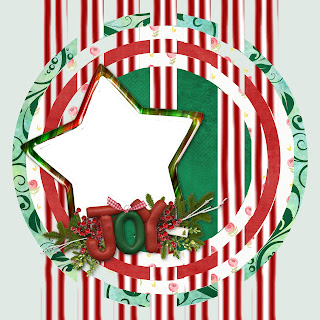I belong to a Facebook Scrapbooking Layout group. One recent post showed a background made of concentric circles woven with vertical strips. Questions were asked for directions but the original poster has not (yet) responded.
Curious, I studied the photo, did some internet sleuthing and have reversed engineered a way to recreate it. I don't know if this was the way the original poster made her layout but this method certainly works. I don't know what the "official" name of this layout technique is; I've simply called it "Woven Circle Background".
I used 4 patterned papers and 1 solid paper. Now, the papers I used aren't terrific. I wasn't sure if my reverse enginering was going to work, so I didn't want to waste "good" paper. The papers you see here are ones that I don't particularly have any fondness for and, as a result, the end product is useable but not really attractive. Don't let that put you off!
It seems as though this layout looks best if two of the papers used for the concentric circles "read" as solids, leaving the last patterned paper being a true pattern.
The patterned papers were for the weaving; the solid paper was for the background/foundation. The original poster also used 4 patterned papers but one of the papers was a duplicate, so there were actually only 3 different patterns. The duplicate pattern was also used for her weaving strips.
I have chosen NOT to do that. To keep the visual easier to see, I opted to use 4 different patterned papers. One patterned paper was used for the vertical weaving strips; 3 patterned papers were used for the circles. The background was plain white.
From 3 patterned papers, cut 5 concentric circles from each one. I used my Scan n Cut to do this and made each ring 1" wide (just for consistency for my initial trial). You can do this manually if you have a compass (remember high school geometry?) The first time, it's easier if you make each circle the same width. BUT for subsequent makes, you could just as easily vary the width of the circles, which would make for an interesting final result.I suppose you could also use metal dies but that would make a miniature version.
When you finish that step, you will have 3 patterned papers cut into concentric circles.
Mentally label the rings from the largest to the smallest as Ring 1, ring 2, etc, until you get to the middle circle and that is #5.
Beware/have caution if you are using directional paper for rings 2 & 4: make sure the direction of the print is facing in the same direction!
Don't glue anything down yet.
Make your concentric circle background; there will be 3 versions you can make.
Take Ring 2 of paper 2 and put it inside Ring 1 (on the foundation paper)
Take Ring 3 of paper 3 and put it inside Ring 2 (on the foundation paper)
Take Ring 4 of paper 2 and put it inisde Ring 3 (on the foundation paper)
Take the inner circle (#5) of paper 1 and put it inside Ring 4 (on the foundation paper).
Here are the other two variations:
Now, take your strips from paper 4. Starting at one edge of the concentric circles you just created, weave the strip in and out of the circles.
Take another strip and weave the 2nd strip in and out of the circles but in the opposite orientation than the first strip. That is to say, if the first strip is OVER a circle, this 2nd strip will be UNDER the circle.
Continue weaving the strips in ths manner until you woven as many strips as you want. I used 7 strips.
I don't think this looks good, so I opted to put the center circle on top of the strips.
Spot glue everything in place. If you are using page protectors, that will keep all the papers from moving. BUT, if you are not using page protectors, then you are going to need to glue everything firmly in place.
Put your matted photos and ephemera on top for the final layout. Voila ... you have just created the background for a layout!
I think it turned out very well!
Please note that Scrapbook Layouts is a private group, which means that you need to join it in order to see the group's discussions. I can't republish Kathy's original photo without her permission.











very talented !
ReplyDelete